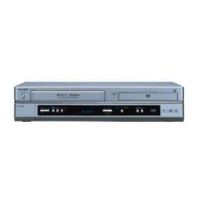• You will not be able to hear all of the sound being output by the VCR/DVD if you use the AUDIO cable (supplied) to a
monaural TV that has only one AUDIO input jack.
NOTES:
• Be sure that the colours of the jacks and plugs match up when connecting the cable.
• Connect the VCR/DVD directly to the TV. If you attempt to view video on a TV connected via a VCR, the copy protection
function will scramble the picture.
• If you want to listen to the audio through audio equipment, connect only the S-VIDEO or VIDEO cable to the TV.
Connecting to a TV Equipped with S-
VIDEO Input Jack (DVD only)
If your TV has no SCART input jack but has an S-VIDEO
input jack, use a commercially available S-VIDEO cable to
connect from the VCR/DVD to the TV. You will still need the
SCART cable or Round coaxial cable for VCR features. (S-
VIDEO connection is available only in DVD mode.)
Connecting to a TV Equipped with
RCA type Input Jack
If your TV has RCA type audio and video input jacks, you
may connect to EURO AV1 (TV) OUT terminal through the
SCART output adaptor (supplied). When using this connec-
tion, do not connect a decoder to the EURO AV2
(DECODER) terminal of your VCR/DVD. Other equipment,
such as a VCR or camcoder, can be connected to EURO
AV2 (DECODER) terminal. If the connected equipment has
RCA type audio and video input jacks, use a SCART input
adaptor (commercially available).
–
10
–
EN
CAUTION:
• Be sure to turn off the VCR/DVD and equipment to be connected before connecting.
• Read through the operation manual for the equipment to be connected.
• Be sure to keep the VCR/DVD connection cables separate from the TV antenna cable when you install the VCR/DVD,
because it may cause electrical interference when you are watching television programmes.
• DTS audio cannot be produced with an analogue connection.
SETTING UP YOUR VCR/DVD COMBINATION
Connecting to a TV or a stereo TV

